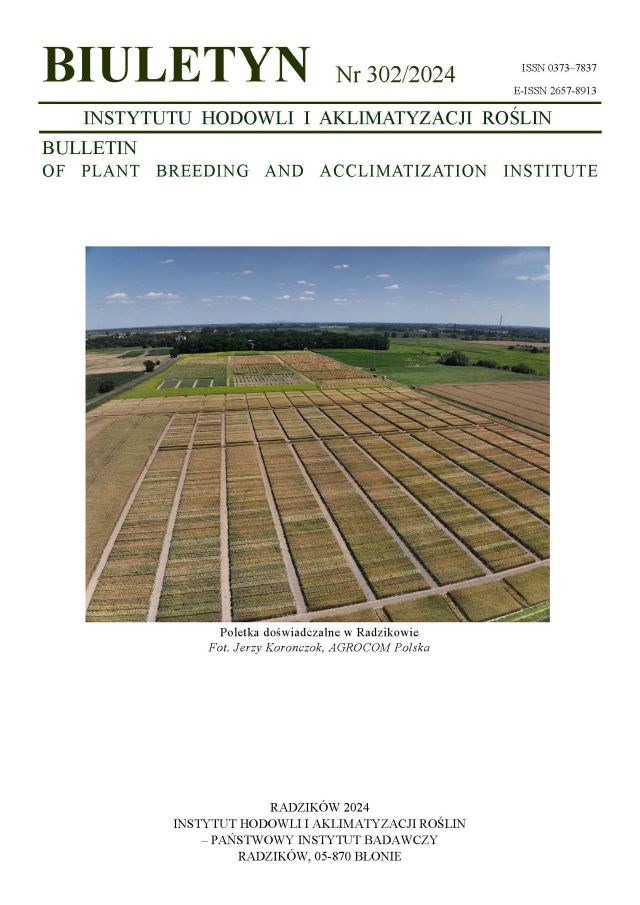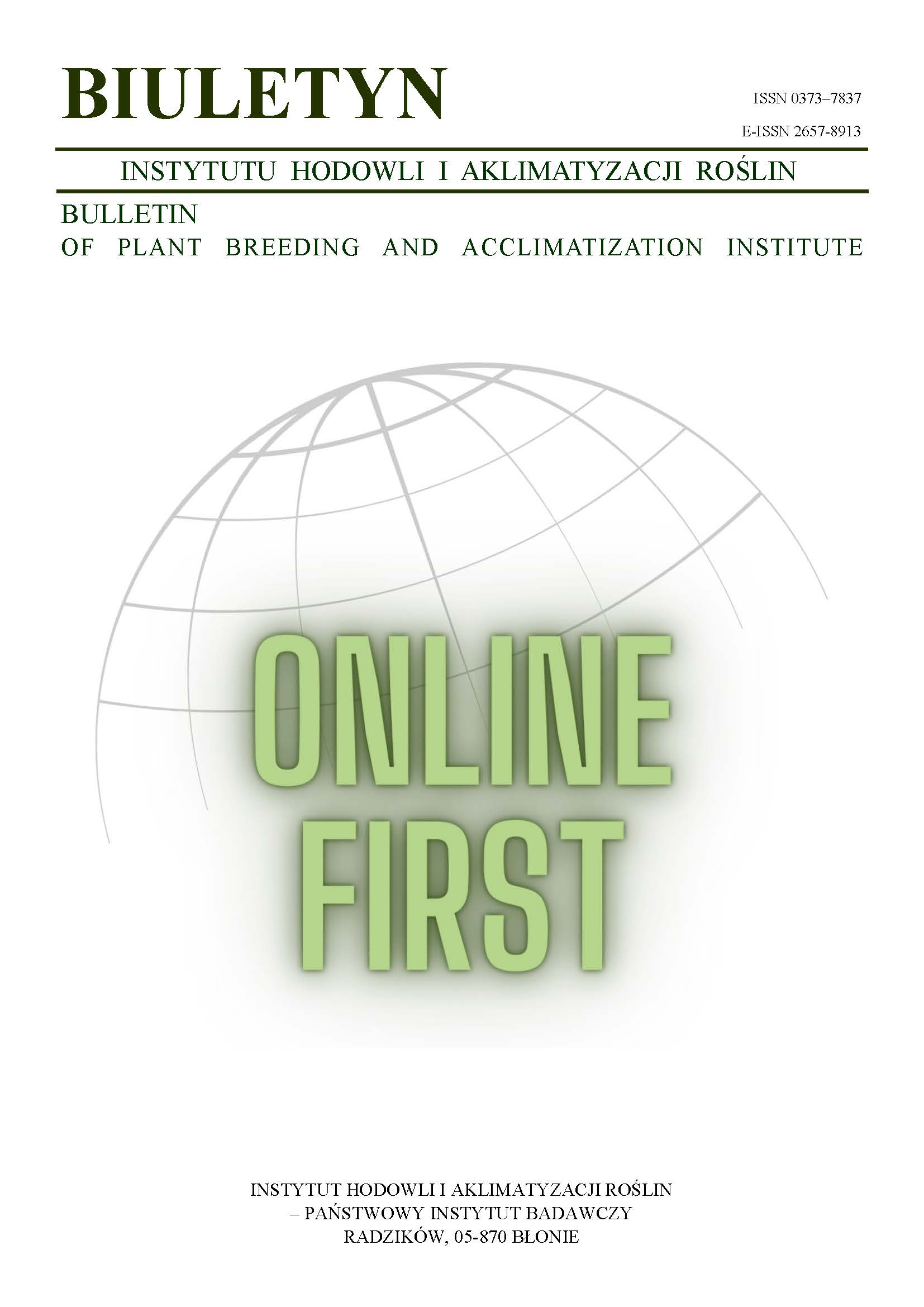Dziedziczenie odporności pszenicy ozimej odmiany Michigan Amber na porażenie przez Pyrenophora tritici-repentis (Died.) Drechsler
Wojciech Wakuliński
wojciech_wakulinski@sggw.edu.plKatedra Fitopatologii, SGGW, Warszawa (Poland)
Czesław Zamorski
Katedra Fitopatologii, SGGW, Warszawa (Poland)
Zofia Białoskórska
Hodowla Roślin „DANKO” Oddział Laski (Poland)
Barbara Łotocka
Katedra Botaniki, SGGW, Warszawa (Poland)
Bogdan Nowicki
Katedra Fitopatologii, SGGW, Warszawa (Poland)
Małgorzata Schollenberger
Katedra Fitopatologii, SGGW, Warszawa (Poland)
Abstrakt
Badano dziedziczenie odporności pszenicy ozimej Michigan Amber na porażenie przez P. tritici-repentis. W pokoleniu F1 wszystkie rośliny uzyskane w wyniku krzyżówek odwrotnych reagowały jak podatne formy rodzicielskie, a efekt cytoplazmatyczny był nieistotny. Występująca w pokoleniu F2 segregacja 3:1 (podatne : odporne) wskazała, że badana cecha w przypadku odmiany Michigan Amber warunkowana jest pojedynczym genem recesywnym.
Słowa kluczowe:
Pyrenophora tritici-repentis, odporność, pszenicaBibliografia
Annone J. G. 1998. Tan spot of wheat in Argentina: importance and disease management. In: Duveiller E., Dubin H. J., Reeves J., McNab A. (eds.) Helminthosporium blights of wheat’s: spot blotch and tan spot. Mexico, D.F. CIMMYT: 339 — 345.
Google Scholar
Bakonyi J., Aponyi I., Fischl G. 1998. Diseases caused by B. sosrokiniana and D. tritici-repentis in Hungary. In: Duveiller E., Dubin H. J., Reeves J., McNab A. (eds.) Helminthosporium blights of wheat’s: spot blotch and tan spot. Mexico, D.F. CIMMYT: 80 — 87.
Google Scholar
Diaz de Ackermann M., Kohli M. M. 1998. Research on Pyrenophora tritici-repentis tan spot in Urugay. In: Duveiller E., Dubin H. J., Reeves J., McNab A. (eds.) Helminthosporium blights of wheat’s: spot blotch and tan spot. Mexico, D.F. CIMMYT: 134 — 142.
Google Scholar
Elias E., Cantrel R. G., Hosford R. M. 1989. Hereditability of resistance to tan spot in durum wheat and its association with other agronomic traits. Crop Sci. 29: 299 — 304.
DOI: https://doi.org/10.2135/cropsci1989.0011183X002900020013x
Google Scholar
Ellis M. B., Waller J. M. 1976. Pyrenophora tritici-repentis. CMI Description of pathogenic fungi and bacteria No 494.
Google Scholar
Evans C. K., Hunger R. M., Sigerist W. C. 1993. Enhanced production of Pyrenophora tritici-repentis conidial suspension. Plant Dis. 77: 981 — 984.
DOI: https://doi.org/10.1094/PD-77-0981
Google Scholar
Frohberg R. C. 1981. Breeding hard red spring wheat for resistance to tan spot. In: Tan-spot of Wheat and Related Diseases Workshop. North Dakota State University, Fargo: 48.
Google Scholar
Jaczewska-Kalicka A. 2000. Zmienność strat plonu pszenicy ozimej powodowanych przez choroby grzybowe w latach 1996–1999. Prog. Plant Protection 40: 623 — 626.
Google Scholar
Jańczak C., Ławecki T., Pawlak A. 1998. Dominujące choroby grzybowe zbóż w 1997 roku i ich skutki. Prog. Plant Protection 38: 468 — 469.
Google Scholar
Lamari L., Barnier C. 1989. Evaluation of wheat lines and cultivars to tan spot (Pyrenophora tritici-repentis) based on lesion type. Can. J. Plant Pathol. 11, 1: 49 — 56.
DOI: https://doi.org/10.1080/07060668909501146
Google Scholar
Lamari L., Barnier C. 1991. Genetics of tan necrosis and extensive chlorosis in tan spot of wheat caused by Pyrenophora tritici-repentis. Phytopathology 81: 1092 — 1095.
DOI: https://doi.org/10.1094/Phyto-81-1092
Google Scholar
Lamari L., Barnier C., Smith R. B. 1991. Wheat genotypes that develop both tan necrosis and extensive chlorosis in response to isolates of Pyrenophora tritici-repentis. Plant Dis. 75: 121 — 122.
DOI: https://doi.org/10.1094/PD-75-0121
Google Scholar
Lee T. S., Gough F. J. 1984. Inheritance septoria leaf blotch (S. tritici) and Pyrenophora tan-spot (Pyrenophora tritici-repentis) resistance in Triticum aestivum cv. Carifen 12. Plant Dis. 76: 92 — 95.
DOI: https://doi.org/10.1094/PD-68-848
Google Scholar
Łukanowski A., Baturo-Czajkowska A., Sadowski C. 2001. Health status of cereals cultivated in different systems with special respect to ecological cultivation. Bulletin OILB/SROP 24: 101 — 106.
Google Scholar
Maraite H., Berny J. F., Goffin A. 1992. Epidemiology of Tan spot in Belgium. Advances in tan spot research. Proceedings of the second international tan spot workshop. June 25–26. North Dakota State University, Fargo, ND: 73 — 79.
Google Scholar
Mehta Y. R., Gaudencio C. A. 1991. The effect of tillage practices and crop rotation on the epidemiology of some major wheat diseases. In: Wheat for nontraditional, warm areas. Saunders D. F. (ed.), Mexico, D.F.: CIMMYT: 266 — 283.
Google Scholar
Murray G.M., Brown J.F. 1987. The incidence and relative importance of wheat diseases in Australia. Australian Plant Pathology 16: 34 — 37.
DOI: https://doi.org/10.1071/APP9870034
Google Scholar
Obst A. 1983. Die Helminthosporium Blattüdre des Weizens. Pflanzenschutzpraxis19: 34.
Google Scholar
Pokacka Z. 1990. Brunatna plamistość pszenicy i pszenżyta wywoływana przez grzyb Pyrenophora tritici – repentis.(Died.)Drechsler. Ochrona Roślin 6: 3 — 5.
Google Scholar
Sarova J., Blazkova V., Hanzalova A., Bartos P. 2001. Incidence and importance of tan spot in the Czech Republic. Sustainable systems of cereal crop protection against fungal diseases as the way of reduction of toxin occurrence in food webs. Book of abstracts, July 2–6, Agricultural Research Institute Kromeriz: 82.
Google Scholar
Shabeer A., Bockus W. W., Norman B. L. 1991. Evidence for cytoplasmatic determinants in the reaction of wheat cultivars to tan-spot. Sarhad J. Agriculture 7, 1: 101 — 104.
Google Scholar
Schilder A. M. C., Bergstrom G. C. 1989. Distribution, prevalence and severity of fungal leaf and spike diseases of winter wheat in New York in 1986 and 1987. Plant Disease 73: 177 — 182.
DOI: https://doi.org/10.1094/PD-73-0177
Google Scholar
Sivanesan A. 1987. Graminicolous species of Bipolaris, Curvularia, Drechslera, Exserohilum and their teleomorphs. Mycol. Pap. 158: 1 — 261.
Google Scholar
Viedma L. Q., Kohli M. M. 1998. Spot blotch and tan spot of wheat in Paraguay. In: Duveiller E., Dubin H.J., Reeves J., McNab A., eds. Helminthosporium blights of wheat’s: spot blotch and tan spot. Mexico, D.F. CIMMYT: 126 — 133.
Google Scholar
Wakuliński W., Zamorski Cz., Nowicki B., Schollenberger M. 2001. Podatność pszenicy i pszenżyta na porażenie przez Pyrenophora tritici-repentis. Biul. IHAR 218/219: 147 — 154.
Google Scholar
Zamorski Cz., Schollenberger M. 1994. The occurrence of tan spot of wheat and triticale in Poland. Genet. Pol. 35B: 375 — 378.
Google Scholar
Autorzy
Wojciech Wakulińskiwojciech_wakulinski@sggw.edu.pl
Katedra Fitopatologii, SGGW, Warszawa Poland
Autorzy
Czesław ZamorskiKatedra Fitopatologii, SGGW, Warszawa Poland
Autorzy
Zofia BiałoskórskaHodowla Roślin „DANKO” Oddział Laski Poland
Autorzy
Barbara ŁotockaKatedra Botaniki, SGGW, Warszawa Poland
Autorzy
Bogdan NowickiKatedra Fitopatologii, SGGW, Warszawa Poland
Autorzy
Małgorzata SchollenbergerKatedra Fitopatologii, SGGW, Warszawa Poland
Statystyki
Abstract views: 4PDF downloads: 12
Licencja
Prawa autorskie (c) 2004 Wojciech Wakuliński, Czesław Zamorski, Zofia Białoskórska, Barbara Łotocka, Bogdan Nowicki, Małgorzata Schollenberger

Utwór dostępny jest na licencji Creative Commons Uznanie autorstwa – Na tych samych warunkach 4.0 Miedzynarodowe.
Z chwilą przekazania artykułu, Autorzy udzielają Wydawcy niewyłącznej i nieodpłatnej licencji na korzystanie z artykułu przez czas nieokreślony na terytorium całego świata na następujących polach eksploatacji:
- Wytwarzanie i zwielokrotnianie określoną techniką egzemplarzy artykułu, w tym techniką drukarską oraz techniką cyfrową.
- Wprowadzanie do obrotu, użyczenie lub najem oryginału albo egzemplarzy artykułu.
- Publiczne wykonanie, wystawienie, wyświetlenie, odtworzenie oraz nadawanie i reemitowanie, a także publiczne udostępnianie artykułu w taki sposób, aby każdy mógł mieć do niego dostęp w miejscu i w czasie przez siebie wybranym.
- Włączenie artykułu w skład utworu zbiorowego.
- Wprowadzanie artykułu w postaci elektronicznej na platformy elektroniczne lub inne wprowadzanie artykułu w postaci elektronicznej do Internetu, lub innej sieci.
- Rozpowszechnianie artykułu w postaci elektronicznej w internecie lub innej sieci, w pracy zbiorowej jak również samodzielnie.
- Udostępnianie artykułu w wersji elektronicznej w taki sposób, by każdy mógł mieć do niego dostęp w miejscu i czasie przez siebie wybranym, w szczególności za pośrednictwem Internetu.
Autorzy poprzez przesłanie wniosku o publikację:
- Wyrażają zgodę na publikację artykułu w czasopiśmie,
- Wyrażają zgodę na nadanie publikacji DOI (Digital Object Identifier),
- Zobowiązują się do przestrzegania kodeksu etycznego wydawnictwa zgodnego z wytycznymi Komitetu do spraw Etyki Publikacyjnej COPE (ang. Committee on Publication Ethics), (http://ihar.edu.pl/biblioteka_i_wydawnictwa.php),
- Wyrażają zgodę na udostępniane artykułu w formie elektronicznej na mocy licencji CC BY-SA 4.0, w otwartym dostępie (open access),
- Wyrażają zgodę na wysyłanie metadanych artykułu do komercyjnych i niekomercyjnych baz danych indeksujących czasopisma.
Inne teksty tego samego autora
- dr Marcin Wit , Piotr Ochodzki , Roman Warzecha , Ada Zawadzka , Monika Żurek , Ewa Mirzwa-Mróz , Emilia Jabłońska , Dorota Bylicka , Józef Adamczyk , Anna Rogacka, Janusz Rogacki , Krzysztof Wójcik , Wojciech Wakuliński , Fusarium temperatum — znaczenie i szkodliwość w uprawie kukurydzy, poszukiwanie i charakterystyka źródeł odporności , Biuletyn Instytutu Hodowli i Aklimatyzacji Roślin: Nr 286 (2019): Wydanie specjalne
- Barbara Łotocka, Marcin Kozak, Krystyna Rykaczewska, Morfologia i anatomia systemu korzeniowego nowych odmian ziemniaka. Część II. Anatomia korzeni , Biuletyn Instytutu Hodowli i Aklimatyzacji Roślin: Nr 279 (2016): Wydanie regularne
- Marcin Wit, Piotr Ochodzki, Roman Warzecha, Wojciech Wakuliński, Znaczenie Fusarium verticillioides (Sacc.) Nirenberg w etiologii fuzariozy kolb kukurydzy , Biuletyn Instytutu Hodowli i Aklimatyzacji Roślin: Nr 245 (2007): Wydanie regularne
- Czesław Zamorski, Bogdan Nowicki, Małgorzata Schollenberger, Wojciech Wakuliński, Podatność polskich materiałów hodowlanych pszenicy na rdzę źdźbłową , Biuletyn Instytutu Hodowli i Aklimatyzacji Roślin: Nr 231 (2004): Wydanie regularne














